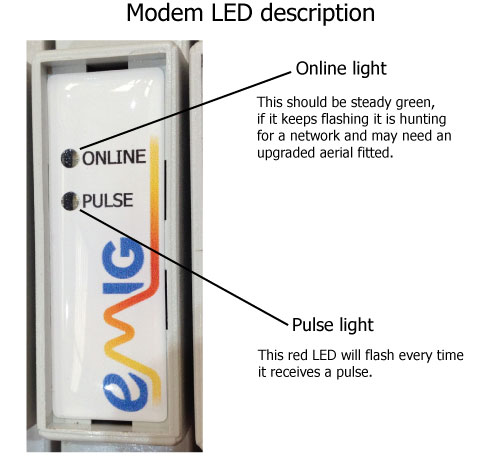
Advice to Installers
To help you to find you way around eMIG hardware, please take a look at eMIG_Data_placement.pdf
To help ensure you have a trouble-free experience with your eMIG meter installation, we recommend that you follow the following advice:
1. Ensure that the modem has a mobile connection before you leave the site
New: in addition to checking the on-line light is continuous, as described below, eMIG now also offers a Pelican Commissioning Service, which gives on-site feedback of signal strength. We strongly recommend that this service is used wherever possible.
The eMIG system relies on a connection using the GPRS / mobile network* to transmit readings to the eMIG web portal. Ensuring that the modem has a network connection is your responsibility.
To avoid repeat visits, it is vital that you check that the modem is connected when you have installed the system.
- Solid green light - healthy connection established.
- Flashing green light - still searching for a network.

If you see a flashing green light which does not become continuous, you should try swapping the standard small aerial that is attached to the modem for a high-gain aerial. It is also beneficial to mount the aerial at a greater elevation or externally if appropriate.
It is recommended that installers carry a range of aerials.
White Solar Systems Ltd supply a range of aerials suitable for different conditions with different gain.
Note that the YAGI aerial is directional. If you are using a directional aerial it is vital that you check the location of the nearest mobile phone cell, using for example The Ofcom Site Finder Website so you can work out the bearing to the nearest suitable mobile telephone cell.
*The Pelican SIM card is able to connect to any of the following mobile networks:
- O2 (Default)
- Orange
- T-Mobile
- Vodafone
Please note: The ‘Three’ network is not covered under the Anynet SIM.
Site Survey Recommendation: It is recommended that finding out the availability of the mobile network in the location where you are installing the the meter / modem and the direction of the nearest mobile phone cell should be part of the site survey prior to installation, so the installer has this information available on site on the day of installation.
2. Record the meter number directly from the meter at the time of installation
The meter number is required for registration with Ofgem and your DNO for claiming the Feed In Tariff (FIT). You are strongly recommended to record the meter number directly from the meter at the time of installation, together with the eMIG ID which is located on the meter box supplied by White Solar Systems Ltd.
PAD Technology Ltd / eMIG accept no responsibility for incorrectly recorded meter numbers being used to register meters; it is your responsibility to record the meter number directly from the installed meter.
3. Check the pulse light is flashing
Next to the GPRS network connection light is a red pulse light that indicates that the Pelican modem is receiving impulses from the meter. Depending upon the meter impulse rate and the load on the meter, you should be able to see this light flashing at regular intervals, indicating that the modem is receiving data from the meter. This is particularly important to check if you are installing an eMIG retrofit, however it is also advisable for new installations where the meter and modem have been factory assembled.
4. Record the pitch, azimuth and percentage shading of the installation
5. RETRO-FIT: Record the meter impulse / kWh rate
For retrofits, it is essential that you record the impulse / kWh rate for the meter which must be entered correctly into eMIG. This is often displayed on the front of the meter, or will be available in the manufacturers documentation for the meter. Some meters allow the impulse / kWh rate to be modified. Ensure that you record the value you have set.
Unsure of the pulse rate? Note a meter reading. Count five or ten pulse flashes on the Pelican* (red LED) and then promptly note the end meter reading. The pulse rate can then be calculated as follows:

* Do not use the pulse light on the meter for this purpose. This often pulses at a different rate to the pulse output to the Pelican.
Pulse rate on retro-fit units
It is recommended to keep the maximum pulse rate below 2 impulse / second.
Several models of three-phase meter allow the pulse rate to be adjusted. PAD Technology are not able to provide advice on individual makes or models of meter however - please consult the meter manufacturer or supplier.
Consult the table below to find the maximum recommended pulse rate for any given maximum kW power rating.
| Maximum expected power (kW) | Maximum advised impulse / kWh (lower is always fine) |
|---|---|
| 4 kW | 2000 |
| 8 kW | 1000 |
| 40 kW | 200 |
| 80 kW | 100 |
| 800 kW | 10 |
| 8 MW | 1 |

